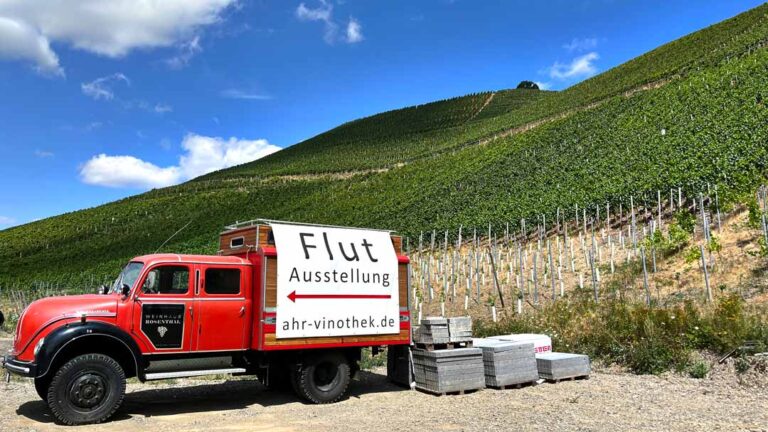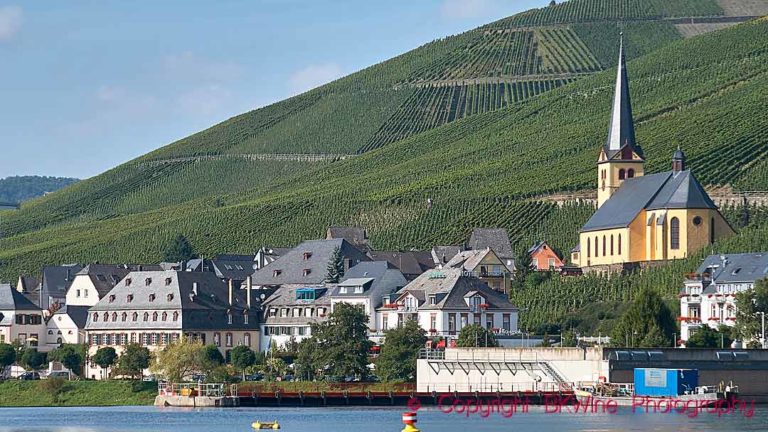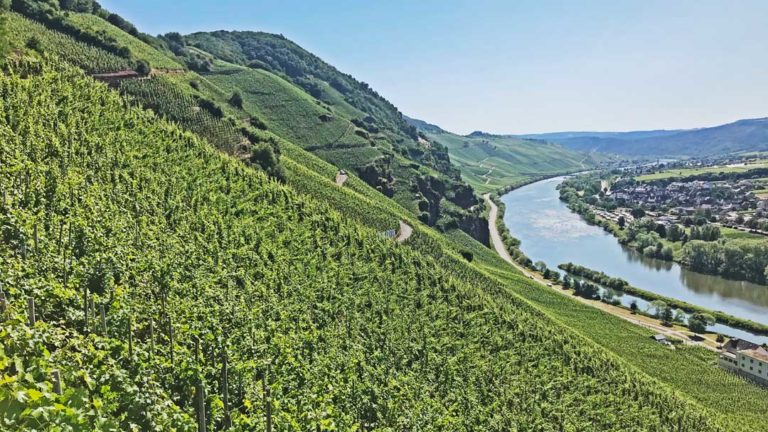There is something very special about hearing Romana Echensperger talk about wine. She is not only one of the few to hold the prestigious title of Master of Wine but also a master at captivating audiences with her infectious laugh and engaging style. During a masterclass in Stockholm organised by German Wines, Romana took us on a journey through Germany’s various wine regions, where we got to dive into what terroir really means and how it affects the wines we drink.
Terroir: How the soil and the microclimate give an imprint on the wine
Romana began by talking about terroir – a concept that she managed to explain in a simple and fascinating way. Germany has a rich and varied geology, resulting in a diversity of soil types in the various wine regions. And these soil types, together with the climate, play a decisive role in how the wine tastes. From the steep slate slopes of the Moselle to the often volcanic soils of the Palatinate (Pfalz) – each region has its own personality that seeps into the bottles.
Slate soils are a classic in the Mosel. The heat-storing slate helps the grapes ripen slowly in the cooler climate and gives the wines a crisp acidity with an evident minerality. These wines are elegant and light, with citrus notes that almost burst with life.
Limestone, found in the Palatinate, Rheinhessen, and Baden, among others, contributes to wines with a softer structure and a delicate balance. The limestone helps retain water in the soil, allowing the grapes to ripen evenly, even in warmer years. Wines from limestone soils often have a creaminess and a certain elegance, perfect for the pinot varieties but also for riesling and chardonnay.
Volcanic soils in regions such as Palatinate, Nahe, and Kaiserstuhl in Baden produce wines with a bit more bite. Here, you often find spiciness and smokiness, which give extra character to the wines. These wines have vibrant acidity and sometimes more exotic fruit flavours.
Loess soil is common in the Rheingau and Franconia (Franken). It is a very fertile soil producing fruity wines with softer tannins and a rounder, more accessible structure. The wines from here often have a prominent fruit profile balanced by a pleasant freshness.
Romana captivated us all with her pedagogical ability to explain the meaning of terroir while keeping the atmosphere light and full of laughter. “It’s not just wine you’re drinking,” she pointed out; it’s a glass of liquid terroir!”
Flight 1: Riesling
We started with a flight of Riesling wines, each expressing its place and soil. My favourite was the Eva Fricke 2022 Kiedrich Riesling Trocken, a perfectly balanced wine between acidity and fruit.
The wine opened with unmistakable aromas of lemon and green apples, which, together with an almost electric acidity, gave it an incredible freshness. The minerality that comes from the sandy loam and quartz-rich soil of the Rheingau was noticeable here. The flavour was sharp and precise, with a long, refreshing finish that made me want to take another sip immediately.
Other wines in flight 1, riesling:
- 2022 Riesling Vom Vulkan, Gut Hermansberg, Nahe
- 2021 Riesling Kanzemer Altenberg GG, Bischöfliche Weingüter, Mosel
- 2022 Riesling Kirschgarten GG, Weingut Phillip Kuhn, Palatinate
Flight 2: Pinot varieties
The next flight focused on pinot varieties. The Weingut Klumpp 2023 Grauburgunder from Baden stood out with its rich, full-bodied style. The soil, with both gypsum-rich keuper and heavy clayey marl, gives the wine an unmistakable minerality and structure. The high clay content adds extra complexity. A quarter of the wine ferments in 500-litre oak barrels, with the yeast remaining for five months, while the rest matures in steel tanks at 17°C.
The result is a fresh wine with minerality and depth. This grauburgunder (pinot gris) was like a hug in a glass—round, full-bodied, yet with a lively acidity that kept it balanced. The aromas were pear and melon, with a hint of almond adding depth. The wine was creamy and almost velvety in the mouth, with a lovely freshness that lifted the flavours.
Other wines in flight 2, pinot varieties:
- 2021 Weissburgunder vom Ranker, Schloss Schönberg, Hessische Bergstrasse (pinot blanc)
- 2022 Weißburgunder, Weingut Hey, Saale Unstrut (pinot blanc)
- 2021 Chardonnay, Weingut Knewitz, Rheinhessen
Flight 3: Aromatic grape varieties
The third series offered aromatic grape varieties. Oliver Zeter 2019 Sauvignon Blanc Fumé from Palatinate (Pfalz), took the lead for me. A sauvignon blanc unlike anything else I’ve tasted – bold, smoky and full of surprises. Not everyone around the table was as excited, so maybe it’s a matter of taste.
Very mixed soil from different parts of the Palatinate gives complexity to the wine. With tropical aromas of passion fruit and guava leaping from the glass and a flinty smokiness from volcanic soil, this wine felt exciting and complex. It was full-bodied and creamy on the tongue, with a healthy acidity that balanced the rich fruit notes. A wine with a strong personality, which takes on and offers a taste journey far beyond the ordinary. But as I said, it’s not for everyone.
Other wines in flight 3, aromatic grapes:
- 2022 Scheurebe Alte Reben, Weingut Heiligenblut, Rheinhessen
- 2021 VINZ Scheurebe, Weingut am Stein, Franconia
- 2023 Sauvignon Blanc, Weingut von Winning, Palatinate
(Ed.: Scheurebe is an aromatic grape grown mainly in Germany and Austria. It is a cross between Riesling and an unknown grape variety.)
Series 4: Wines with residual sweetness
The closing series, with fruity and sweet Riesling wines, really delivered. My favourite was the Maximin Grünhaus 2022 Abtsberg Riesling Kabinett. This producer has long been a personal favourite when it comes to Kabinett, hyper-elegant wines at great prices. This wine from the “grand cru” location Abtsberg was a perfect example of how Moselle’s schist-rich soil produces Riesling wines with an outstanding balance between acidity and sweetness.
Here, delicate notes of peach and apricot were backed by a sparkling acidity that made the wine feel fresh despite its sweetness. The slate provided a subtle minerality that held the flavours in place and gave the wine a long, elegant finish. It’s really delicious. Think of a ceviche with the saltiness from the shrimp, the fruit of mango, and the acidity of lime, and you’re at home!
Other wines in flight 4, wines with residual sweetness:
- 2022 Bockstein Riesling Kabinett, Weingut Nik Weis, St. Urbanshof, Mosel
- 2022 Terra 50 Riesling Feinherb, Weingut Corvers Kauter, Rheingau
- 2023 Riesling Kabinett Rotlack, Schloss Johannisberg, Rheingau
A journey through German terroir with laughter and insight
Romana Echensperger’s masterclass was more than a wine tasting – it was an educational journey through Germany’s wine landscape, where we got to experience how terroir affects each glass. Thanks to German Wines, who organised the event, we really got a taste of Germany’s unique wine world.
The wines from Eva Fricke, Weingut Klumpp, Oliver Zeter, and Maximin Grünhaus all showed how the German soils contribute to shaping the character of the wines. From the crisp and mineral-driven riesling to the full-bodied grauburgunder and the smoky fumé blanc, to finally the elegant balance of the Abtsberg Riesling Kabinett, each wine demonstrated the importance of the terroir. With Romana as our guide, the trip was both fun and memorable.














